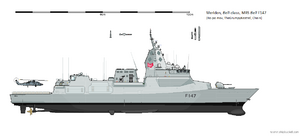Bell-class frigate
 Bell, lead ship of the Bell-class frigates.
| |
| Class overview | |
|---|---|
| Builders: |
Algiers Maritime Engineering, Smith Island, |
| Operators: |
|
| Preceded by: | Mystere-class destroyer |
| Succeeded by: | Helena-class destroyer |
| Subclasses: | Rourke-class cruiser |
| Built: | 2018-present |
| In service: | 2020-present |
| Planned: | 22 |
| Building: | 3 |
| Completed: | 5 |
| Active: | 4 |
| General characteristics | |
| Class and type: | Guided missile frigate, anti-submarine warfare frigate |
| Displacement: | 7,200 tons, full load |
| Length: | Overall: 420 feet |
| Beam: | Overall: Around 68ft |
| Draught: | 26 ft |
| Propulsion: |
list error: mixed text and list (help)
|
| Speed: | In excess of 35 knots |
| Range: | In excess of 7000 nm at 18kts operating on electric motors |
| Complement: | 160, with capacity for up to 200. |
| Sensors and processing systems: |
|
| Electronic warfare & decoys: |
|
| Armament: |
list error: mixed text and list (help)
2x Goalkeeper CIWS 16x MSS-33 anti-ship missiles 2x triple torpedo tubes for MSU-90 anti-submarine torpedoes |
| Armour: | Kevlar over vital spaces |
| Aircraft carried: | 2x H50M5 normally carried |
| Aviation facilities: | Enclosed hangar for up to 2x H50M5 Hawk |
The Otapara-class is a class of eight guided missile destroyers in service with the Meridonian Navy. Initially designed as all-spectrum multi-purpose destroyers to replace a number of surface combatants in the Navy, cost concerns and perceptions about its lack of ability to effectively counter next-generation threats particularly in the air-to-air arena due to the lack of modular space available (particularly with radar and guidance systems for missiles) saw it optimized into a 'general purpose' (GP) destroyer oriented as a surface action group leader and multi-purpose destroyer. The first ship, Otapara, was commissioned in 1998, with the last, Anamaru, commissioning in 1993. While 20 of these vessels were initially planned, 12 were cancelled. 6 of the twelve were converted to Rourke-class cruisers, and material from the other two currently in construction were cannibalized to contribute to this.
The Otapara-class is the largest surface warfare vessel built for the Navy since the 1950s, and is one of the most heavily armed destroyers in the world. Considered a cruiser in some circles, it was designed to meet virtually every mission set expected of a surface combatant. Originally armed for air defense with MSA-6 and 7 missiles, all have since been upgraded by 2010 to utilize the Common Air Defense System suite of missiles. It is additionally capable of anti-shipping warfare with box-launched MSS-33 and VLS-launched MSS-18 cruise missiles, the latter of which are also capable of land attack; and anti-submarine warfare with embarked anti-submarine helicopters, MSU-14 antisubmarine rocket torpedoes.
Description
Design

The Otapara-class was originally conceived as a standardized class of destroyer able to perform all necessary functions expected of a future surface combatant, including provisions for flag facilities as leaders of surface action groups. Replacing older Mystere-class vessels, they offered a substantially increased capability in anti-ship and land attack warfare, the latter being the first introduction of the capability from a surface ship with the introduction of VLS tubes. 20 ships were originally planned, however due to the high cost related to fitting and arming an Otapara-class destroyer and its percieved inadequacy in the air defense role, the Helena-class destroyer was designed to specialize in air warfare and form the bulk of a surface action group. This lead to the emergence of the semi-formal designation of the Otapara-class as a 'general purpose' destroyer, as opposed to the 'air wafare' destroyer Helena-class.
Construction
Propulsion
Armament and protection
Flight deck and aircraft facilities
Strike groups
Design differences within the class
Ships in class
| Ship | Pennant number | Laid down | Launched | Commissioned |
|---|---|---|---|---|
| MRS Otapara | D30 | 23 March 1985 | 12 April 1988 | 33 November 1988 |
| MRS Kaimai | D31 | 10 July 1985 | 24 December 1988 | 30 August 1989 |
| MRS Kaihiku | D32 | 2 June 1986 | 30 March 1989 | 20 February 1990 |
| MRS Ohikati | D33 | 13 November 1986 | 20 March 1989 | 11 March 1990 |
| MRS Rotoma | D34 | 24 July 1987 | 14 July 1990 | 2 January 1992 |
| MRS Whitikau | D35 | 18 February 1988 | 2 January 1991 | 11 January 1992 |
| MRS Pipiroa | D36 | 2 March 1989 | 3 March 1992 | 16 December 1992 |
| MRS Anamaru | D37 | 20 December 1989 | 14 December 1992 | 3 May 1993 |